Navigating cultural constructs, post-modern philosophy and places as diverse as the sweaty dance halls of northern Europe to intimate moments of contemplation while writing letters, Lise Haller Baggesen culls an intersection that merges contemporary thought and practice while examining an array of popular and obscure topics (e.g., disco, hedonism, the works of Julia Kristeva, to name a smattering). Recently, the COMP Magazine had a chance to visit Baggesen’s studio that rests on the North Branch of the city’s primary waterway to discuss her multilayered 2014 book Mothernism, her recent exhibitions in the city, her role as an educator, and how these experiences have translated into interpreting the hyper-speed cultural transformation occurring in contemporary life.
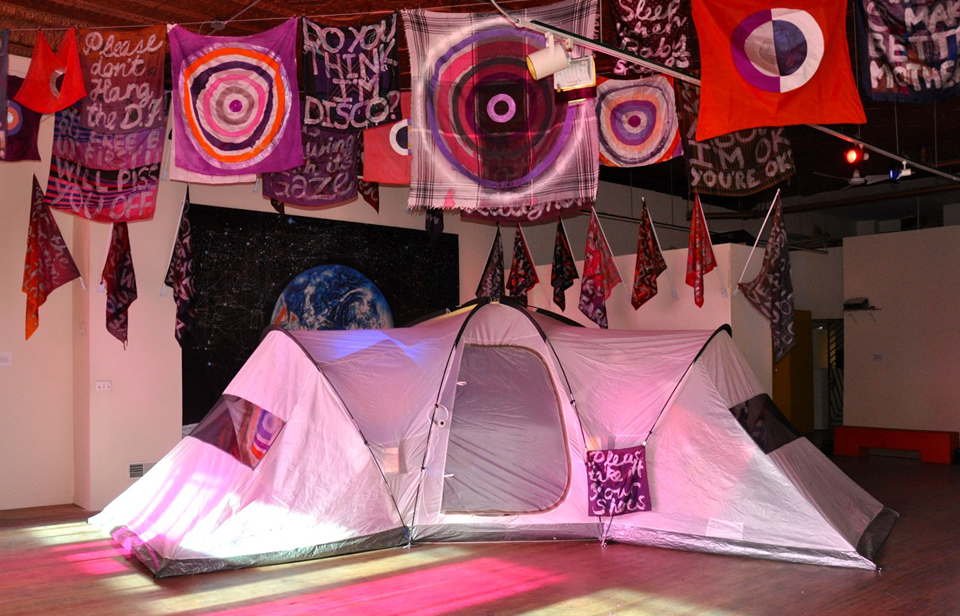
Mothernism, Audio Installation, CoProsperity Sphere, Chicago 2013 (Photo by Lise Haller Baggesen)
Can we start with a little background? You grew up in Denmark, studied in the Netherlands at AKI and the Rijksakademie (Amsterdam), and now reside in Chicago. Are there specific events or memories that you refer to from these experiences that inform your artistic practice?
Before leaving Denmark, I spent two years at Billedskolen, a private art school in Copenhagen. It was very small, just five teachers and about 60 students, and completely unpretentious. Almost like yoga, in the sense that it was entirely practice based; do your practice and all will be revealed. So, I started very slowly and traditionally, with drawing and painting from still-life and live models.
I worked as a croquis model for years – it was my student job throughout college – so I guess my work always related (and continues to relate) directly to the human body, the human figure, and the human scale. As a side effect, I have no problem with nudity or sitting still.
In Copenhagen there is a beautiful museum called Glyptoteket, which houses the private collection of Carlsberg’s founder Carl Jacobsen. The collection holds some gorgeous Bonnards and Gaugains, among other seminal artworks. I did not have a TV or a phone while I lived in Copenhagen, and I didn’t have a lot of money. The museum was free on Wednesdays, so I used to go there and just sit, look, and reflect upon the paintings. I got really good at this.
I also wrote a lot of letters, which is my favorite mode of writing. Presently, I find that there are only two things worth writing: love letters and hate mail.
Enschede, where I did my BFA, is a post-industrial college town in the east of The Netherlands. At this time, I lived in a student commune with a shared phone and MTV playing perpetually. The painting department’s studios were housed in a former village school, way out in the countryside, so again I found myself working in a fairly secluded setting, among a small group of peers. In the morning we would bike out along the dykes and sheep pastures to paint all day, and at night we would go out. The city had quite the nightlife for its size. It was right on the German border and attracted a large diverse audience, due in part to the liberal Dutch drug laws and the burgeoning dance scene in Holland with its expanding Raves, featuring the hottest Techno, Trance and Gabber DJ’s.
Also, the Grunge scene was big – this being the early 90s – we all knew or played in a band regularly at a local student bar or other venue, and then came the camp disco revival. The best disco in town was a gay club, an enormous multi-storied dance dome. Everybody went there, the atmosphere was part dance factory with a very industrial sense. You could say that my move from Denmark to the Netherlands, and from the 80s and into the 90s, was my own little (post) industrial revolution and that Enschede imprinted me musically as well as painterly in a way that informs my work and writing to this day. Enschede was provincial, yes – something which is often frowned upon – and hedonistic, but these days provincial hedonism is a scarce commodity, and perhaps something we need to value more?
When I moved to Amsterdam to attend the Rijksakademie, my outlook got a lot more international and professional, and my work got a fair amount of attention, which was great – but actually I think it is not a bad idea to start by learning to endure silence, repetition and loneliness. And hedonism. Enduring success is great, but these are your basics.
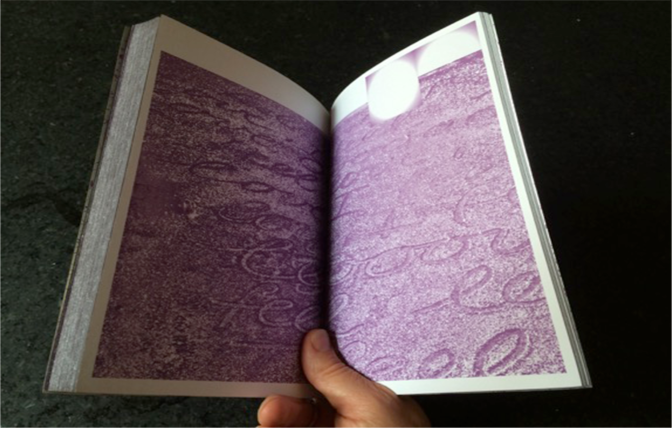
Mothenism, Book, Green Lantern Press/Poor Farm Press, Chicago 2014
(Graphic Design by SonnenZimmer, Photo by Lise Haller Baggesen)
What do you value most in the art making practice?
I love studio time. Even when difficult, it is an indulgence to be alone with your thoughts.
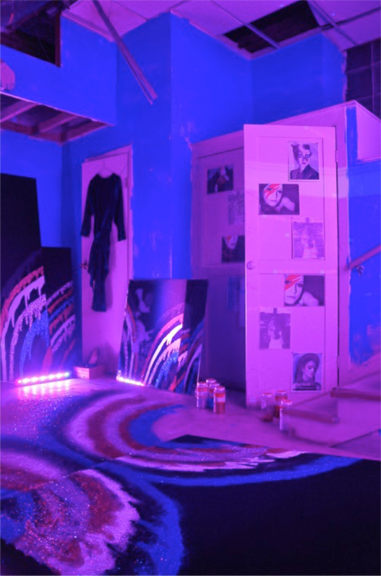
So Deep In Your Room, You Never Leave Your Room, Installation, Chicago, 2012 (Photo by Lise Haller Baggesen)
Your website (https://lisehallerbaggesen.wordpress.com) functions as a blog, show room, reading room, and introduction to Mothernism. To say you are comprehensive in your approach would be an understatement. What impact has the ability to present your voice and work online had on your ongoing investigations?
Writing can get you into quite an intimate headspace, something I am sure you have experienced if you are a reader yourself. You take your book with you to bed, to the bathroom or on travels. I use a very direct address, a letter format, to get that intimacy with my reader. It is interesting to discover how Mothernism –a piece of writing which originated as my thesis project and as such was intended for a small audience—has had a very broad appeal, exactly because of that.
One thing I experienced, since the book was released last year, is how a text can lead a life of its own. For example, I got a friend request on Facebook by Bracha Ettinger—who’s work I admire and cite as primary text—but I was mystified as to how she knew about me, so I asked. Turns out that my book was recommended to her by a student in Mexico (a place I have never been). This response was quite exhilarating to discover. My writing was in some way translating my voice beyond its initial intent. Bracha urged me to apply for a conference in London, Motherhood and Creative Practice, where she was designated as the keynote speaker. We met for the fist time last June. She is a rock star! To hear her speak about her own practice as a writer, psychoanalyst and artist, along with other prominent scholars in the field, such as Natalie Loveless, Tina Kinsella, Faith Wilding and Griselda Pollock, was super inspiring.
The London conference directly preceded our own Mothernists conference in Rotterdam, Holland. This was initiated by Deidre Donoghue of Dutch artist and research group M/Other Voices and myself. We started fairly small, but decided to extend the invitation to a group of American artist/scholars who were planning to be in London (Chicago’s own Miriam Schaer from Columbia College and Christa Donner of Cultural ReProducers among them). The culminating result was a three day symposium and an art exhibition. As a nice aside, I also had the opportunity to be a guest lecturer at the Rijksacademie while visiting Holland. This felt like a real homecoming!
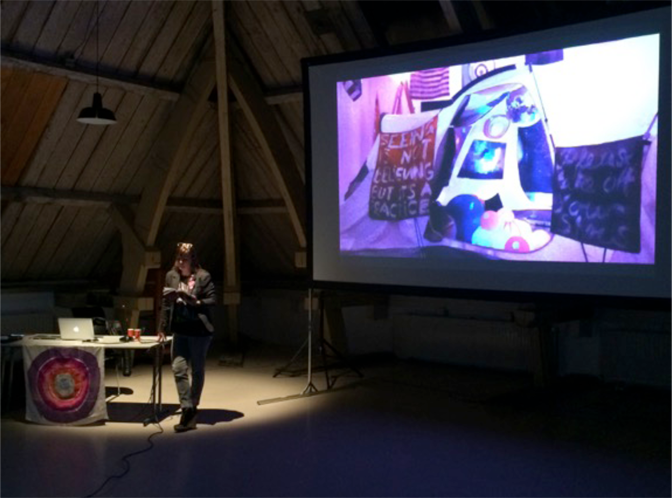
Mothernizing RABK, Lecture, Rijksacademie van Beeldende Kunsten, Amsterdam 2015 (Photo by Skafte Aymo-Boodt)
In that sense, getting my work online has meant that I have found a community, I would not otherwise have had access to, which translates back again to my work (and I) traveling the world.
In 2014, you published Mothernism with Green Lantern Press and Poor Farm Press. This publication is the culmination of an extended effort that also has been presented in exhibition form. Can you provide a summary of the process?
The first iteration of Mothernism was my MA VCS thesis in 2013. The project started quite timidly with my suggestion to write a thesis on “the overlap and similarity between maternal, curatorial and artistic practice.” That proposal was met with so much pushback from my peers, that I eventually decided to “go big or go home”. Instead of making a project “about motherhood”, I opted to make a “gesamtkunstwerk,” an installation that worked “something like a mama” and was rooted in my studio practice, as much as my academic research.
It must be said that I would never have had the courage to push this project out in the world in such a bold manner without the support of my thesis committee. They encouraged and supported this prject in so many ways. Romi Crawford informed the process and content with conversations on everything from Bling to L’ecriture Feminine, to the historical importance of letter writing as a mode of feminine and feminist address. Michelle Grabner, my 1st reader, not only provided me with the initial opportunity to show the installation outside of the SAIC at the 2013 Great Poor Farm Experiment, but also offered to publish the materials via Poor Farm Press. I suggested to co-publish with Green Lantern Press and Caroline Picard. We edited the writing together. Under Picard’s critical and intuitive mentorship the voice transformed from a thesis to a book. Caroline introduced me to Sonnenzimmer, the duo who is responsible for its quite gorgeous graphic design. Sonnenzimmer transformed the content again from “just” a book to a desirable object.
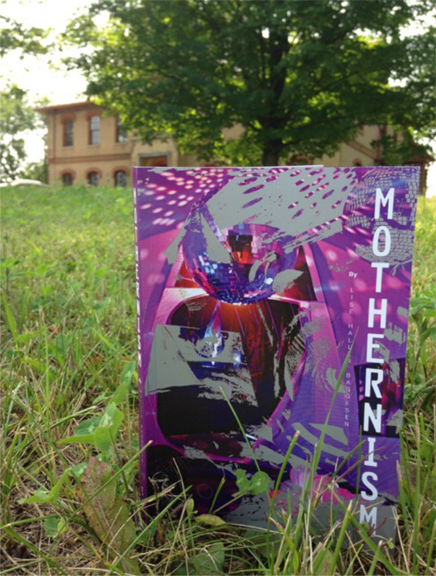
Mothernism, Book, Green Lantern Press/Poor Farm Press 2014
(Photo by Michelle Grabner)
You discuss an interest in cross-pollination and an attraction to “blurred boundaries” and those times “when things get messy”. How do you sort through these varied items (disco, family, interior decoration, etc.) to produce something coherent and digestible?
Gosh! Reading my own words back to myself sounds like some weird Robin Thicke kind of sexual innuendo, I suppose, in many ways, it is. Although there are righteous objections to that tune, I must admit to have a soft spot for the kind of ditty that purrs like the synthetic lovechild of James Brown’s “Sex Machine” and David Bowie’s “TVC 15.”
But it gets better/worse: I mentioned Paul Gauguin earlier. He is an old flame of mine, who’s name I’ve heard slandered all over the place with derogatory terms like “Colonist” and “Sex-Tourist.” Yes, these notes may be accurate from one standpoint. He has been accused (and probably rightly so) of everything to introducing syphillis to Polynesia, to cutting off Vincent van Gogh’s ear (van Gogh was supposedly so drunk during the incident that he took Gauiguin’s word for it to be self inflicted). And then you get to ask yourself how many sex tourists are active today, and how many of those get to alter the course of art history forever? I don’t need Paul Gauguin like a fine wine – I need him like a Tequila sunrise. He is coarse and smutty, refined and spiritual. As such Gauguin teaches me more about the complex bilateral desire(s) of females. The same goes for filmmaker Lars von Trier, who has often been accused of being misogynist, but whose female characters are multi-faceted, complex and flawed, hence relatable. These characters are like my real life heroines: The oeuvres of Colette, Lispector, Blixen, and Brøgger, (to name but a few favorites) offer us disparate intimate accounts of the female psyche and are examples of what Kristeva calls “the maternal genius” – which may conflate with, but should not be confused with, “the good mother.”
Interpretation is complicated. Should be: it’s complicated.
The bottom line is this: In my view, the next feminist revolution must be all about female desire. This desire is complex and multifaceted and runs the gamut from sexual liberation, to work force participation, to political prowess, to, yes, child bearing and rearing. As such the content must speak in a Cacophonous voice with a Pollyannaish inclination.
I am not interested in being labeled as “Good Feminist,” “Bad Feminist,” “White Feminist,” “Bad Ass Feminist,” “Power Feminist,” “Lean In Feminist,” “Lipstick Feminist,” “Queer Feminist,” “Eco Feminist,” etc. Although, I am sure at various points and turns in my navigating the roadmap of intergenerational and intersectional feminism. I have channeled all of the above. What I am very interested in is to be a “Good Enough Feminist.” (To Paraphrase Klein.)
As (female) human beings we navigate in many different cultural spheres and engage in many-splendored interpersonal relationships (not all of them consensual). My writing wishes to acknowledge this.
Whether the result is coherent and digestible is up to you, Dear Reader, you decide.
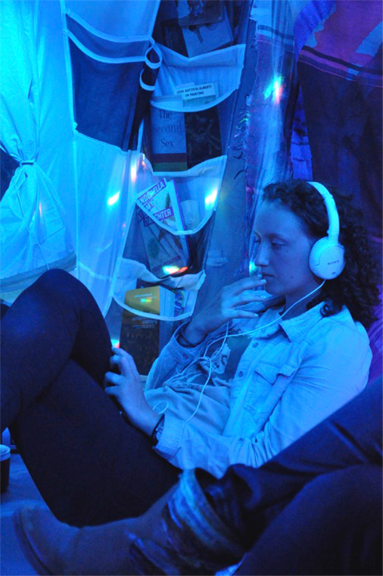
Mothernism, Audio Installation (Detail), The Great Poor Farm Experiment, Manawa (WI) 2013 (Photo by Jonathan Ross)
You are also an educator. Does this experience have any influence on your investigations?
I have a long running partnership with CAPE (Chicago Artist Partnership in Education) where I do a residency at a primary school for a few weeks every year. While the American Education system, and CPS in particular, frustrates me with it’s emphasis on “teaching to the test” it is also a challenge to figure out a new project every year that can give the kids an “A Ha! Moment” making connections between the physical material in front of them and the learning material they have been studying. I am paired with a science teacher. This type of collaboration is great. Every unit we do needs to be tied in with the current science curriculum. Over the years, we have done units with 4-8th graders on as disparate topics as Hydrophobe/Hydrophile Chemistry, Evolution, Mass Extinctions, Metamorphosis, Terraforming and Pollution – all good things to know about as preparation for the future.
This semester I started teaching a “Mothernism” class at the SAIC. It is really great to come back and teach at the department for Visual and Critical Studies, which is where the project originated. To me, the magic of VCS, again, is in the idea of synthesis –the connections between your own practice, the theoretical material you bake into it, and the larger world you are connecting it to.
I guess this idea of synthesis also translates back into the studio practice –and into collaborative projects I have engaged in outside of the studio; like for example “Boulevard Dreamers” which Kirsten Leenaars and I created for The Franklin, and later presented in the MCA.
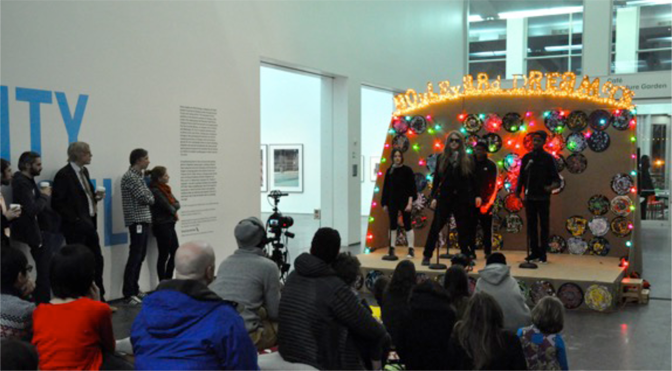
Boulevard Dreamers (Collaboration with Kirsten Leenaars), Installation, Performances and Photo Archive,
MCA Chicago 2014 (Photo by Jonathan Ross)
You are preparing for a show at Threewalls in Chicago. Can you share with us your intent for this exhibit? Also, do you have any additional exhibits or plans for 2015-2016?
Yes, I am working on a new body of work for a show at Threewalls in the spring and for a show at the Suburban in Milwaukee in Fall 2016. I am excited about both, but it is a little too early to give away any details.
In the meantime, I am focusing on the task at hand: In the very short term (mid October) I will be traveling to Paris with Tricia van Eck for a project she curated for Focus Chicago called “Pleasure Zone,” about the politics of pleasure. This project will be realized at various hidden locales inside the Théâtre de la Ville. My installation “Sound of Silver, Talk To Me” will be situated in a bar not usually open to the public, so that will be fun!
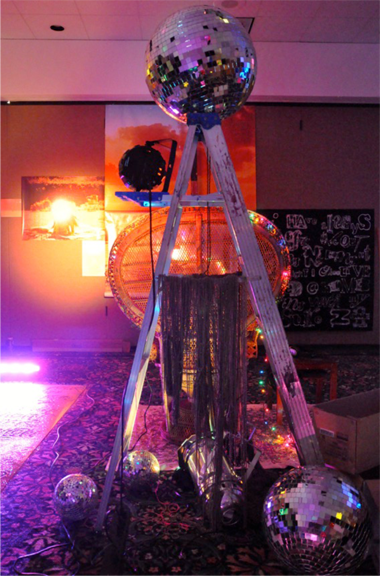
A Space Where Your Voices Can Live, Audio Installation, 6018 North for EXPO Chicago 2013 (Photo by Lise Haller Baggesen)
Mothernism will be on show this winter and spring at The Elmhurst Museum Biennial (IL), The Elisabeth Foundation in NY, and at my first museum solo at The Austin Contemporary (TX). Each iteration of the piece will take a new form and adapt to the given space. As the three shows overlap, I am producing new material, both in the form of flags and banners for “Hi(gh) Mothernism!” in the Mies van der Rohe House at Elmhurst Art Museum, and “ The Mothernist’s Guide to Laguna Gloria,” a commissioned audio piece for The Austin Contemporary, which I am currently researching.
I have been invited to co-curate next year’s Great Poor Farm Experiment in Wisconsin, together with Danish/American artist Yvette Brackman, so we are in the early stages of that now, applying for funding and so on, inviting a diverse group of Scandinavian and Midwestern artists, to engage in bilateral conversations and art making about migration and diaspora, belonging and indigenousness, in the rapidly shifting (art) ecology and political landscape of the 21st century.
Finally, I guess what unites all the practices I engage in, be it art production, writing, curating, educating, or –yes- parenting, is a connection of the personal with the political (to use a never antiquated phrase) and a sense of place and belonging within in a bigger agency. We all need agency. And world peace! And if we can’t get it right the first time we can practice. Practice. Practice. Practice.
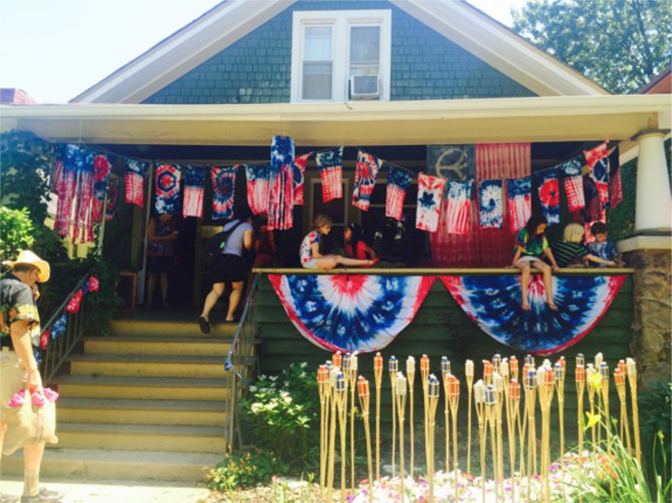
Peace in the US! Installation and Peace Out, Terrain, Oak Park 2014 (Photo by Jonathan Ross)
For additional information on the work of Lise Haller Baggesen, please visit:
Lise Haller Baggesen – http://www.baggesen.org/
Art 21 Magazine – http://blog.art21.org/2015/06/10/lise-haller-baggesen-on-the-mother-shaped-hole-in-contemporary-art/#.VhaDDBNViko
Flats Studio – http://flatsstudio.com/item/lise-haller-baggesen/
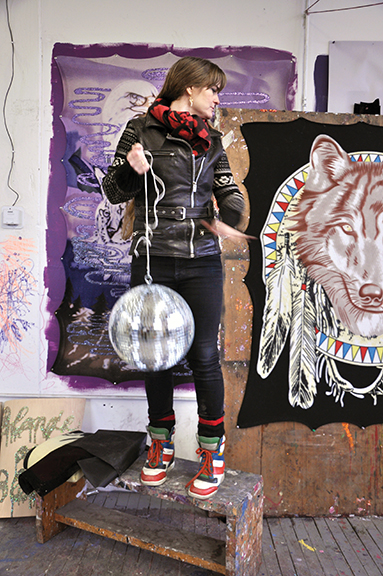
Lise Haller Baggesen, artist, Chicago, 2015
Interview and portrait by Chester Alamo-Costello


